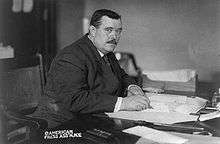William J. Flynn
| William J. Flynn | |
|---|---|
 | |
| Director of the Bureau of Investigation | |
|
In office July 1, 1919 – August 22, 1921 | |
| President |
Woodrow Wilson Warren Harding |
| Preceded by | William E. Allen (Acting) |
| Succeeded by | William J. Burns |
| Personal details | |
| Born |
November 18, 1867 New York City, New York, U.S. |
| Died |
October 14, 1928 (aged 60) Larchmont, New York, U.S. |
William James Flynn (November 18, 1867 – October 14, 1928) was the director of the Bureau of Investigation from July 1, 1919 to August 21, 1921.
Personal life
Flynn was born in New York City and began his government career in 1897, after receiving a public school education.
Early career
Flynn began his career as a Manhattan plumber.[1] His first law enforcement job was as an agent in the United States Secret Service. He spent many years combating counterfeiting, which led to his investigation and arrests of Black Hand extortionists and members of the American mafia, many of them associated with the Morello crime family.[2]
Flynn collaborated with New York Police Department Detective Giuseppe "Joe" Petrosino, who was murdered in 1909 in Palermo, Sicily, where he was tracing the backgrounds of the gangsters plaguing New York City. Petrosino's murder was never officially solved, but author/historian Mike Dash implicates the likely triggerman and his accomplice and says there is little doubt that Giuseppe Morello was behind it.[2] Flynn and his operatives built the case that culminated in the 1910 convictions of Morello and his associates and their imprisonment at Atlanta Federal Prison.[1]
Flynn gained recognition in 1911, when he successfully reorganized the New York City detective force. He later returned to the Secret Service as Chief (1912–1917). During World War I, he served as Chief of the United States Railroad Administration's Secret Service, investigating threats of sabotage.
FBI career
In 1919, Flynn was named director of the Bureau of Investigation. Attorney General Palmer praised his new appointee as "the leading, organizing detective of America...Flynn is an anarchist chaser...the greatest anarchist expert in the United States." In one of Flynn's high profile incidents, one of his operatives who was trailing German diplomat Dr. Heinrich Albert on a streetcar, snatched Albert's briefcase, which contained sensitive documents. The papers documented Albert's having spent $27 million to build up a spy network in the United States, using German money to fund dock strikes, attacks on shipping, and bombs planted in munitions plants.[2]
Resignation
On September 27, 1921, Flynn resigned saying he had a "private business matter to accept." Attorney General Harry Daugherty accepted the resignation immediately and appointed William J. Burns to the position.
Soon thereafter, the true reason for Flynn's resignation emerged. Flynn's hard-line approach to counterespionage and his scaremongering public statements meant to rouse the USA to the threat of German espionage angered the German and Irish communities, and eroded Flynn's support in Washington.[4]
After resigning, Flynn "accepted a sinecure as head of the Federal Railway Administration Police."[4]
Reinstatement and replacement
Two years after leaving the Secret Service, in the wake of concerted terrorist action, including a bomb that "shook the home of A. Mitchell Palmer, the attorney general of the United States, virtually demolishing it", Palmer "dedicated his Department of Justice to tracking down the men responsible." He appointed Flynn director of the Bureau of Investigation. Flynn took charge of hunting down the bombers and assigned "an ambitious Justice Department clerk by the name of J. Edgar Hoover" to monitor suspected radicals.[4]
Through painstaking work, Flynn's team identified the likely suspects. However, they were unable to obtain the type of evidence that would stand up in court. Public opinion turned against the bureau, as the public wanted arrests, and Hoover launched a series of "Palmer Raids" that became a public relations nightmare. These events resulted in low morale among Flynn's staff, and the new Harding Administration replaced Flynn with William J. Burns.[4]
Semi-retirement
After his forced retirement, Flynn went into business for himself. He founded a New York detective agency with his daughter Veronica and son Elmer as partners, which generated some income. However, reports author/historian Mike Dash, the partnership was unsuccessful and contributed to the business's ultimate demise: Veronica and Elmer "were running the detective business into the ground. Both heavy drinkers, they overspent and upset clients. The pair's increasingly erratic behavior distressed their more abstemious father, and the worry weakened him."[4]
Flynn earned the bulk of his income, at that point, from writing.[4] He had occasionally contributed articles, typically about his greatest cases, to such journals as The New York Herald and The Washington Post since 1911. After retiring, he worked briefly as a crime novelist.[5] Additionally, through his acquaintance with the actor King Baggot (who, Dash notes, in 1912was considered the greatest film star in the country), Flynn became a scenario writer for the motion picture industry. Producers Theodore and Leopold Wharton collaborated with Flynn to adapt Flynn's experiences into a 20-part spy thriller motion picture titled The Eagle's Eye (1918), starring Baggot.[4] The associated book was titled: The Eagle's Eye: A True Story of the Imperial German Government's Spies and Intrigues in America from Facts Furnished by William J. Flynn, Recently Retired Chief of the U.S. Secret Service[6]
He also edited a magazine which bore his name, Flynn's Weekly Detective Fiction, which became the longest-running, most successful journal of its genre.[4] After Flynn's death, the periodical was temporarily renamed Detective Fiction Weekly (formerly Flynn's) before resuming its original title; the periodical published a total of 703 issues since its inception.[7]
Death
Flynn died at age 60 of heart disease in October 1928,[4] in Larchmont, New York. He is buried in a family plot in Valhalla, New York.[8]
References
- 1 2 Kinchen, David M. "BOOK REVIEW: Mike Dash's 'The First Family' Traces American Mafia Back to Its Beginnings with Giuseppe Morello, the 'Clutch Hand' Founding Godfather". Huntington News.
- 1 2 3 Dash, Mike (2009). The First Family: Terror, Extortion and the Birth of the American Mafia. London: Simon & Schuster. ISBN 978-1-84737-173-7.
- ↑ "The Broad Ax". Illinois Digital Newspaper Collections. Feb 10, 1917. p. 6. Retrieved 30 July 2015.
- 1 2 3 4 5 6 7 8 9 Dash, Mike (2009). The First Family: Terror, Extortion and the Birth of the American Mafia. London: Simon & Schuster. p. Epilogue, page 10. ISBN 978-1-84737-173-7.
- ↑ Flynn, William J. The Barrel Mystery. The James A. McCann Company. ISBN 9781486484843.
- ↑ Cooper, Courtney Ryley & Flynn, William James. The Eagle's Eye: A True Story of the Imperial German Government's Spies and Intrigues in America from Facts Furnished by William J. Flynn, Recently Retired Chief of the U.S. Secret Service. ASIN B009QJTQCO.
- ↑ "Crime, Mystery, and Detective Pulps: Detective Fiction Weekly". MagazineArts.org.
- ↑ Dash, Mike (2009). The First Family: Terror, Extortion and the Birth of the American Mafia. London: Simon & Schuster. p. Epilogue, page 36. ISBN 978-1-84737-173-7.
- Biograph of William J. Flynn at the Federal Bureau of Investigation
- William J. Flynn at CBS News
- History of the Federal Bureau of Investigation at the Intelligence Resource Program of the Federation of American Scientists
- "Early Days of the Intelligence Community: Bureaucratic Wrangling over Counterintelligence, 1917–18" at the Central Intelligence Agency
- White, Frank Marshall (May 1912). "The New Chief Of The Secret Service: Mr. William J. Flynn And His Adventure To Enforce The Law Against Counterfeiting". The World's Work: A History of Our Time. XXVI: 33–39. Retrieved 2009-07-10.
External links
| Wikimedia Commons has media related to William J. Flynn. |
- Works by William J. Flynn at Project Gutenberg
- Works by or about William J. Flynn at Internet Archive
| Government offices | ||
|---|---|---|
| Preceded by William E. Allen Acting |
Director of the Bureau of Investigation 1919–1921 |
Succeeded by William J. Burns |

